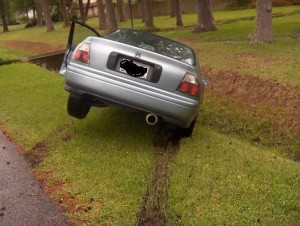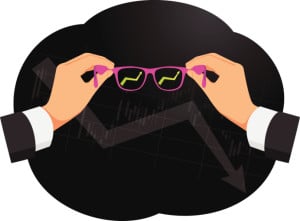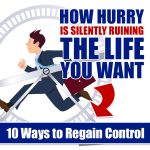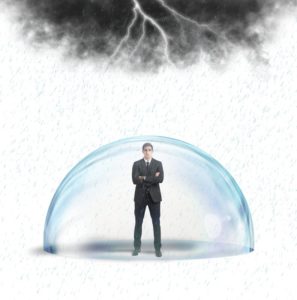 Have you ever thought you were making good decisions that promised to make life better… and instead things got worse?
Have you ever thought you were making good decisions that promised to make life better… and instead things got worse?
Things go off the road… and you are now a passenger in the unfolding of events?
Then a friend of yours, trying to be encouraging, says “it will get better! The disaster is actually a blessing! It’ll eventually turn out good…”
After shooting them and disposing of their body, you want to scream, “Why did this happen? It seemed like I made a good decision at the time!”
What you may not know is there was something influencing your decision that you couldn’t see.
Making Good Decisions- Unseen Forces Are At Work
 Did you know there was something steering you toward making a decision that was ripe for a disaster.
Did you know there was something steering you toward making a decision that was ripe for a disaster.
Research psychologists have now documented a unique bent we humans have that continues to mess up our decision-making process.
Even when we conscientiously seek to choose the best path, this unseen factor tricks us into choosing the wrong path… and continues to trick us as events unfold.
If you can understand and take this factor into account when think you are making good decisions, you will significantly increase the likelihood of a better outcome.
Our Blind Spot: Predictive Bias
 Here’s the problem: Psychological research has conclusively determined that humans are consistently overly optimistic in their decision-making predictions. In other words, we humans habitually believe the paths we choose are going to turn out just as rosy as we imagined.
Here’s the problem: Psychological research has conclusively determined that humans are consistently overly optimistic in their decision-making predictions. In other words, we humans habitually believe the paths we choose are going to turn out just as rosy as we imagined.
Reality and research prove otherwise… and we are caught unprepared.
Now, being optimistic is generally a good thing with many benefits. But, in this case, it causes us to approach decisions in a distorted way, leading to poor outcomes.
 For example, let’s say Sam loves good food, loves to cook, and feels he has some great recipes. He has always dreamed of starting his own restaurant where people are loving the food, so he takes his life savings to finance his dream and is off and running.
For example, let’s say Sam loves good food, loves to cook, and feels he has some great recipes. He has always dreamed of starting his own restaurant where people are loving the food, so he takes his life savings to finance his dream and is off and running.
Sam’s decision turns out badly. Why? Well, in part because he was so optimistic about the outcome that he didn’t do certain essential things that would have given him a better chance to succeed… or helped him make a better, more informed decision in the first place.
Why are we so prone to seeing only a rosy outcome? And more importantly, how can we take this human proclivity into consideration to avoid getting on a seemingly attractive horse that promises to take us to our hoped for destination but instead takes us on a ride where we don’t want to go?
Why We Keep Getting Fooled By This Distortion
Research has identified three factors that conspire against us, leading us to be convinced again and again that things will turn out a certain way (and, as a result, we enter into things unprepared).
- What You See Is All There Is. Researcher Daniel Kahneman notes the human fallacy of assessing a situation exclusively on the variables we can see… and discounting or ignoring the myriad of other factors that would influence both the decision and the outcome.
Sam based his decision to open a restaurant on the fact that he was a good cook and a food connoisseur.
“I am a good cook.”
“A good cook makes food people like.”
“A good restaurant is one that serves food people like.”
“My restaurant will be successful because I am a good cook.”
 Of course, there is much more to running a successful restaurant… like the business side. However, Sam focused on what he could see and assumed that was all there was to see (or in this case, all he needed to see).
Of course, there is much more to running a successful restaurant… like the business side. However, Sam focused on what he could see and assumed that was all there was to see (or in this case, all he needed to see).
This isn’t just Sam’s problem.
Have you ever noticed you don’t need many pieces of information to draw a conclusion that you feel is sound? If a friend comes to you with a problem and shares a few pieces of the story, you are generally quick to come up with advice… and feel like you offered good advice. Unfortunately, there is usually more to the story we didn’t know or consider.
We are all susceptible to making judgments and decisions based on “what you see is all there is.”
We may not have all the facts, but we are seldom in doubt with our conclusions… even when they are flat wrong. - That Doesn’t Apply To Me. Another quirk in human nature that leads us to be overly optimistic in how things will turn out is that we view ourselves and our situation as being outside the law of averages.
For example, in the U.S. the chances of a small business surviving for at least 5 years is only 35%. For restaurants it is even worse: 60% are out of business in just 3 years.
But, for some reason people starting a business don’t think those numbers apply to them.
— 81% are very confident their business will do well
— 33% are convinced they have a zero chance of failure
 In another example, although by definition only 50% of people can be considered “above average” in a category, a full 90% of people consider themselves as an above average driver.
In another example, although by definition only 50% of people can be considered “above average” in a category, a full 90% of people consider themselves as an above average driver.
Are you kidding me? If you have ever driven on the interstate system, you know that can’t possibly be true.
Now, before you shake your head about those people out there deluding themselves, let me ask you — Do you consider yourself a “good” driver… or an average driver?
Uh-huh. I thought so…
This bias toward dismissing the undeniable numbers because “they don’t apply to me… or my situation” leads to choices that bite us on the rear end at a later point. - I Knew That Would Happen. Another factor conspires against us. Our “predictive memory” is also distorted. When events occur, our minds trick us into thinking we saw it coming. In reality, the mind simply reconstructs the facts with the benefit of hindsight.
 As a result, we think we can reliably predict the future… because we have done it so many times in the past (which we really haven’t). We enter into new predictions with overconfidence based on a distorted view of the past.
As a result, we think we can reliably predict the future… because we have done it so many times in the past (which we really haven’t). We enter into new predictions with overconfidence based on a distorted view of the past.
Researchers Fischhoff and Beyth conducted a test of respondents who were asked to assign the probability of 15 possible outcomes prior to a series of events. After recording those predictions and the events played out, the researchers asked those surveyed to report what probability they recall assigning to those events.
The result?
— If an event actually occurred, people consistently exaggerated the probability they originally thought it would happen. In other words, what they thought was a possible occurrence before the event became a “likely” outcome in their distorted memory.
— If a predicted event didn’t occur, they recalled being sure it wouldn’t (even though earlier they had predicted it would).
 Their “hindsight bias” caused them to see their past predictions in a much more favorable light, which boosted confidence in their future prediction making abilities.
Their “hindsight bias” caused them to see their past predictions in a much more favorable light, which boosted confidence in their future prediction making abilities.
How unreliable are human predictions? Philip Tetlock’s experiments on predicting outcomes demonstrated that even the best human predictors (who were experts in a field and were predicting outcomes in that field) were correct slightly more often than flipping a coin.
We really don’t know what the future holds.
Here’s what you need to remember: When we make decisions based on how we think those choices will turn out, we must assume we will be wrong as often as we are correct… and prepare accordingly.
How To Combat Our Predictive Bias
Since none of us is infallible in decision-making, one of the best techniques to protect yourself is called a tripwire.
The term comes from the realm of the military and describe a wire stretched close to the ground around the perimeter of a camp, so that when someone disturbs or “trips” the wire, it sets off an alarm that stirs the soldiers in camp into action.
 A tripwire in decision making identifies conditions determined in advance that warrant action. Think of it as the low gas light on your dashboard. When it pops on, you need to change your actions (be on the lookout for a gas station).
A tripwire in decision making identifies conditions determined in advance that warrant action. Think of it as the low gas light on your dashboard. When it pops on, you need to change your actions (be on the lookout for a gas station).
Tripwires have two key benefits in decision making:
- They objectively alert you when there is a problem you need to address. For example, if Sam had set a tripwire ahead of time that said he needed to see at least 40% of his first time customers return (indicating they thought the restaurant was good enough to come back to and share with others), he would have been alerted that something was amiss when his restaurant consistently fell short.It would alert him that he needed to change something to improve that number… and if it continued, he would be wise to pull the plug.
- Limit the downside of a decision/path that isn’t improving. Without tripwires, we often keep pouring ourselves and our resources in a direction that isn’t getting better (what is called “the sunk cost fallacy”).
We are so caught up in the direction we are going and the emotional and possibly financial investment made up to that point (“I’ve already come so far… and spend a lot of money”) that we easily rationalize why staying the course makes sense.
What do we typically say to ourselves when things are not going well, but we desperately want to believe they will change? “Let’s just wait and see what happens… let’s give it a little more time.”
A tripwire alerts you that certain conditions you determined previously are or are not happening, and it is time to take a different course of action (including possibly cutting your losses if that is what you determined before you started).
Two Basic Tripwires You Can Use
- Time-based. “If this happens (or doesn’t happen) within the next 6 months, then I will respond by doing X.”
- Situation-based. “If the stock gets below X, I will sell it regardless.”
If you and I have a tendency to see and believe the most optimistic outcome, tripwires alert us to a needed course correction, including cutting our losses.
I can personally attest: tripwires work!
Making Good Decisions: What To Do Next
Next time you are about to make a decision, pause and think about what conditions or situations (good and bad) you need to see to ensure your decision is on the right trajectory (or that indicate it is going in the wrong direction). You will never be more clearheaded than before you plunge into the decision.
Taking just a few minutes to think through some tripwires will increase the likelihood the decision will turn out well (because of course corrections) and potentially save you from a very bad outcome.
Do you want to learn a complete, scientifically proven process for making better decisions and avoid regrets? Download the free report:
5 Scientifically Proven Steps To Making Better, More Successful Decisions.
It includes a step-by-step guide designed to maximize your decision-making results.
Go ahead and download it now… it’s free!









Please note: I reserve the right to delete comments that are offensive or off-topic.